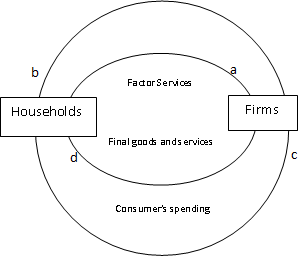Circular Flow in Money Economy
In the beginning barter continued without much difficulty because the volume of transaction was low and mode of production was simple. As civilizations grew, mode of production became complex. Innumerable goods and services came into use. As a result barter system encountered several difficulties. These difficulties cleared the way for the invention of money. Now we turn to circular flow in a money economy.
In money economy, the households receive factor income in terms of money in from of wage, interest, rent and profit in exchange of the factor service sold to the firms. In the process money income lies with the households and goods lie with the firms. Now the households spend their money income to purchase final goods from the firms. So there is a flow of expenditure from the households to the firms for the purchase of goods and services. The flow is complete when goods and service reach the households and the expenditure of the households (which is income of the firm) reach the producing sector (firm). This is shown below.
Fig.2. Circular Flow in Money Economy
Circular flow of money – (b) and (c)
Circular flow of goods – (a) and (d)
The supper part shows flow of factor services to the firm and flow of factor income – wage, rent, interest and profit to the households. The lower part of the diagram shows flow of expenditures to the forms and counter flow of final goods and services to the households.
The above model assumes that all income of the households is spendable and is spent. No savings and investments emerge. So this is a two sector simple economy without saving and investment.

